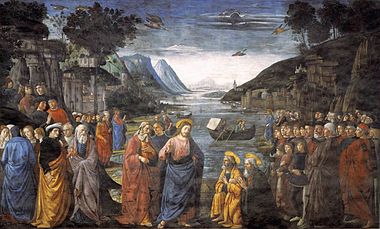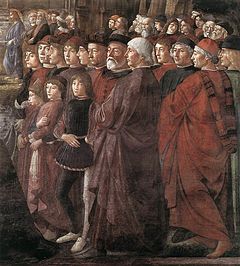- Vocation of the Apostles
-
Vocation of the Apostles 
Artist Domenico Ghirlandaio and workshop Year 1481-1482 Type Fresco Dimensions 349 cm × 570 cm (137 in × 220 in) Location Sistine Chapel, Rome The Vocation of the Apostles is a fresco by the Italian Renaissance painter Domenico Ghirlandaio, executed in 1481-1482 and located in the Sistine Chapel, Rome.
History
In 1481 a group of Florentine painters left for Rome, where they had been called as part of the reconciliation project between Lorenzo de' Medici, the de facto ruler of Florence, and Pope Sixtus IV. The Florentines started to work in the Sistine Chapel as early as the Spring of 1481, along with Pietro Perugino, who was already there.
The theme of the decoration was a parallel between the Stories of Moses and those of Christ, as a sign of continuity between the Old and the New Testament. A continuity also between the divine law of the Tables and the message of Jesus, who, in turn, chose Peter (the first alleged bishop of Rome) as his successor: this would finally result into a legitimation of the latter's successors, the popes of Rome.
Two frescoes are certainly by Ghirlandaio, the Vocation of the Apostles and the Resurrection, which was repainted in the late 16th century due to extensive damage. A third, the The Crossing of the Red Sea, in the "Stories of Moses" wall, has been assigned to one among Ghirlandaio, Biagio d'Antonio or Cosimo Rosselli.
Description
The scene of the Vocation shows, above a lake in a wide mountainous valley, the fishermen Peter and Andrew (on the left) in the moment in which they are called by Jesus, who stands on the shore. A few time later, the two are behind Jesus on the opposite shore (on the right), while the latter calls James and John, who are restoring the nets on their father Zebedee's boat, in the center of the scene.
In the foreground are Peter and Andrew, already dressing the cloaks with their traditional colors (yellow or orange for Peter, green for Andrew). They are kneeling beside Christ who solemnly bless them. An original element of the fresco is the presence of a moltitude of beholders, portrayed in contemporary clothes. Their faces were those of the Florentine community in Rome, who resided near the church of Santa Maria sopra Minerva.
At the left is a white bearded man, perhaps a literate from Constantinople who was also used as model for the St. Jerome in His Study in the church of Ognissanti in Florence. At the center, just behind Jesus, is the portrait of Diotisalvi Neroni, who had taken refuge in Rome after plotting against Piero di Cosimo de' Medici. Another exile from Constantinople is John Argyropoulos, who appears on the right. Other characters on the right are members of the Tornabuoni family.
Sources
- Santi, Bruno (2001). "Ghirlandaio". I protagonisti dell'arte italiana. Florence: Scala.
Categories:- 1480s paintings
- Domenico Ghirlandaio paintings
- Sistine Chapel
- Fresco paintings
Wikimedia Foundation. 2010.


